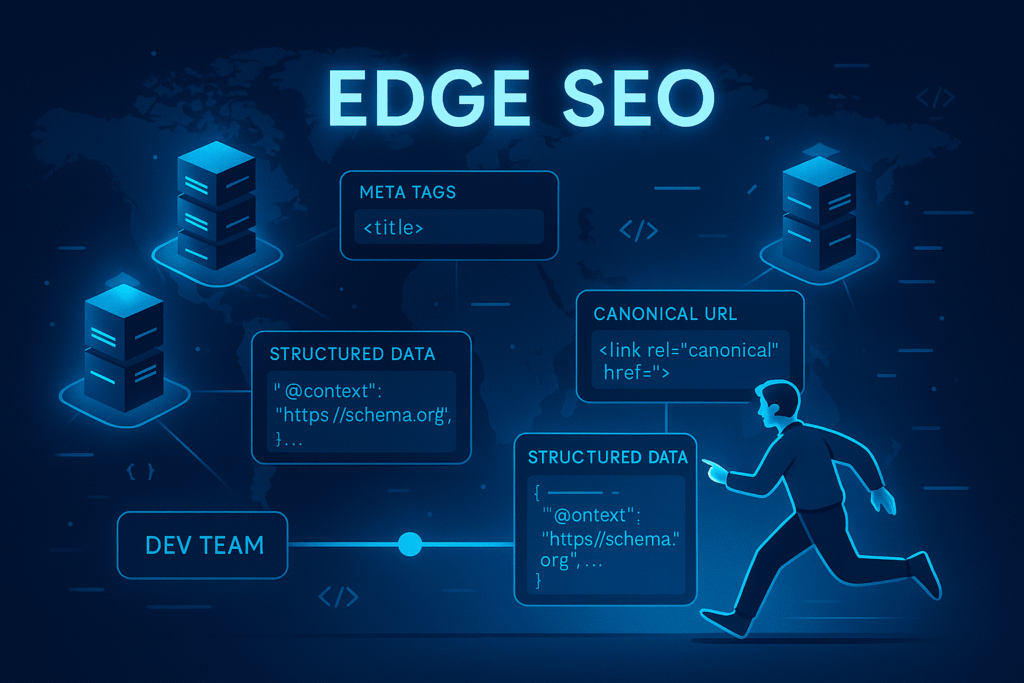In the fast-paced world of SEO, speed isn’t just for page loading—it’s about implementation. You know that moment when you spot a canonical issue or a missing hreflang tag, and your dev team says, “We’ll add it to the next sprint”? Weeks pass. Your rankings tank. Frustrating, right? -> Enter Edge SEO—a game-changing solution that lets you bypass the dev queue and fix things right at the edge, no backend required.
Let’s dive into how Edge SEO actually works, what you can do with it, and how to put it into practice without touching a single line of source code.
What Is Edge SEO (and Why Should You Care)?
Edge SEO is the practice of making SEO-related changes at the edge of a content delivery network (CDN), closer to the user. It’s like duct-taping fixes onto your website mid-flight, but in a smart, scalable, and controlled way.
It’s useful when:
- You can’t get developer time.
- You’re running A/B tests.
- You need to react fast (think Google updates).
- You’re working with international or enterprise-level sites.
With Edge SEO, you inject, rewrite, or remove SEO-relevant content—such as tags, headers, schema—without waiting for the actual site code to change. That means faster fixes, real-world impact, and more control for SEO professionals.
Why Traditional SEO Implementation Is Broken
Traditional SEO execution is too slow for the modern web. Every change has to go through layers of approvals, code reviews, QA, staging, deployment… just for a <link rel="canonical"> fix? That’s inefficient.
Edge SEO disrupts that workflow. It empowers SEOs to roll out critical updates instantly—on the serverless layer—so users (and search engines) see the optimized version right now, not next month.
The Power of the Edge: How It Works
The “edge” refers to edge servers—global nodes on a CDN like Cloudflare, Akamai, or Fastly. These nodes serve content to users faster by caching and processing data close to their physical location.
With Edge SEO, you can:
- Intercept a request at the edge.
- Modify the HTML response before it reaches the browser.
- Add or edit SEO elements like meta tags, canonicals, structured data, etc.
No CMS access needed. No code deployment. Just smart rewrites via edge functions.
What Can You Actually Fix with Edge SEO?
Let’s look at some real, practical SEO tasks you can implement instantly using Edge SEO tools.
Canonical Tags (Fixes and Corrections)
Canonicals are often misused or forgotten altogether. When your site has pagination issues or duplicate content, a wrong canonical can hurt rankings. Edge SEO lets you insert or rewrite canonical tags on the fly.
Example:
Let’s say your /blog?page=2 is pointing to itself instead of the main blog page. You can use an edge function to dynamically rewrite the canonical to /blog—across all paginated URLs—without touching the CMS.
hreflang Tags for International Sites
Implementing hreflang tags the right way is tricky. With Edge SEO, you can inject hreflang headers or tags dynamically based on the country and language of the user or URL.
Why it matters:
Incorrect hreflang setups can lead to indexing issues, traffic loss, and duplicate content problems across regions. Edge SEO lets you test and fix hreflang errors instantly—without rewriting templates across thousands of URLs.
Structured Data Injection
Schema.org markup is crucial for rich results. But if your CMS doesn’t support it or your dev team delays implementation, you miss out.
Edge SEO allows you to inject structured data like:
- Article schema
- Product schema
- FAQ schema
- Breadcrumbs
All on the edge—valid, crawlable, and ready for Google’s bots.
Meta Tag Fixes and Updates
Got missing or duplicate meta descriptions and titles? Want to test alternate phrasing?
Edge SEO lets you manipulate <title> and <meta> tags based on rules, URL patterns, or user-agent detection.
It’s especially handy during audits when you find hundreds of thin or duplicate meta tags and need a temporary patch while the real fix is in the pipeline.
Case Study: Fixing a Broken hreflang Setup Without Dev Help
The Problem:
A global SaaS brand had 5 country sites—but no working hreflang tags. English versions were cannibalizing each other’s rankings.
The Edge SEO Fix:
Using Cloudflare Workers, we injected the correct hreflang headers into all country-specific pages, dynamically detecting language and location via URL patterns.
The Outcome:
Within two weeks, hreflang errors in Search Console dropped to zero. Each country version began ranking in its proper market. No dev involvement, no downtime.
Top Tools for Edge SEO Deployment
Here’s a short list of tools you can use to get started with Edge SEO today:
- Cloudflare Workers – Popular and flexible; great for rewriting headers, injecting schema, and modifying HTML.
- Akamai EdgeWorkers – Enterprise-level tool, best for large brands already using Akamai CDN.
- Netlify Edge Functions – Developer-friendly with great documentation for headless sites.
- Edgemesh or Sloth – SEO-specific platforms built for non-devs wanting to implement Edge SEO fixes.
You don’t need to be a full-stack dev to use these tools. But you do need to understand what changes to make—and where.
Benefits of Edge SEO (You’ll Never Want to Go Back)
- Speed: Roll out changes in hours, not weeks.
- Control: Own the fixes, without chasing engineers.
- Testing: Run SEO experiments without dev deployment.
- Agility: React fast to algorithm changes or competitors.
It’s a paradigm shift. You’re no longer waiting—you’re driving.
What to Watch Out For
Edge SEO is powerful, but not without risk. A few warnings:
- Overriding Critical Dev Logic: Make sure your edge fixes don’t clash with real app logic or security headers.
- Caching Conflicts: Improper setup may lead to inconsistencies between cached and live content.
- Scalability Issues: Be smart—don’t overload edge functions with complex logic that should be done in your CMS.
Use it wisely. Test in staging. And always monitor what’s being rewritten.
Final Thoughts
Edge SEO isn’t the future—it’s the now. If you’ve ever felt like you’re doing 100 audits just to watch 10% of them get implemented, Edge SEO flips the script.
With smart tools and the right knowledge, you can execute fast, effective SEO fixes that actually go live. No more excuses. No more bottlenecks.
Want to get started the smart way? Explore automation-ready SEO solutions with SEO Sets—where edge logic meets real-world ranking wins.
FAQs
What skills do I need to implement Edge SEO?
You don’t need to be a developer, but some familiarity with JavaScript and how HTML works helps. Most tools come with templates you can tweak.
Is Edge SEO safe for large websites?
Yes—but only if you know what you’re doing. Test thoroughly, document every change, and avoid overwriting critical security or content headers.
Can I use Edge SEO with WordPress or Shopify?
Absolutely. Since it runs on the CDN level, Edge SEO works regardless of your CMS. You just need access to the CDN layer or a platform that supports edge functions.
How fast do changes appear to search engines?
Immediately—once deployed. Googlebot will see your updated meta, canonical, or structured data the next time it crawls your page.
Is Edge SEO a replacement for development?
No. Think of it as a fast lane—not a substitute. Use it to fix or test, then push permanent changes through development cycles when ready.


